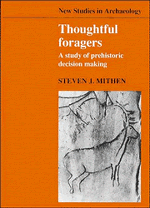Book contents
- Frontmatter
- Contents
- List of figures
- List of tables
- Preface
- 1 Introduction
- PART ONE LEARNING FROM THE PRESENT
- PART TWO MESOLITHIC FORAGING AND SOCIETY
- PART THREE UPPER PALAEOLITHIC ART AND ECONOMY
- 7 Seeking the decision maker: faunal assemblages and hunting behaviour
- 8 Through a hunter's eyes … and into his mind?
- 9 Conclusion
- Bibliography
- Index
8 - Through a hunter's eyes … and into his mind?
Published online by Cambridge University Press: 04 August 2010
- Frontmatter
- Contents
- List of figures
- List of tables
- Preface
- 1 Introduction
- PART ONE LEARNING FROM THE PRESENT
- PART TWO MESOLITHIC FORAGING AND SOCIETY
- PART THREE UPPER PALAEOLITHIC ART AND ECONOMY
- 7 Seeking the decision maker: faunal assemblages and hunting behaviour
- 8 Through a hunter's eyes … and into his mind?
- 9 Conclusion
- Bibliography
- Index
Summary
After we have responded to a work of art, we leave it, carrying away in our consciousness something which we didn't have before. This something amounts to more than our memory of the incident represented, and also more than our memory of the shapes and colours and spaces which the artist has used and arranged. What we take away with us – on the most profound level – is the memory of the artist's way of looking at the world. The representation of a recognizable incident (an incident here can simply mean a tree or a head) offers us the chance of relating the artist's way of looking to our own. The forms he uses are the means by which he expresses his way of looking. The truth of this is confirmed by the fact that we can often recall the experience of a work, having forgotten both its precise subject and formal arrangement.
Yet why should an artist's way of looking at the world have any meaning for us? Why does it give us pleasure? Because, I believe, it increases our awareness of our own potentiality. Not of course our awareness of our potentiality as artists ourselves. But a way of looking at the world implies a certain relationship with the world, and every relationship implies action. The kind of actions implied vary a great deal. A classical Greek sculpture increases our awareness of our own potential physical dignity; a Rembrandt of our potential moral courage; a Matisse of our potential sensual awareness. Yet each of these examples is too narrow to contain the whole truth of the matter. […]
- Type
- Chapter
- Information
- Thoughtful ForagersA Study of Prehistoric Decision Making, pp. 226 - 255Publisher: Cambridge University PressPrint publication year: 1990



